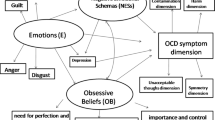Conclusions
It seems clear that the psychasthenic and schizophrenic reactions are qualitatively, as well as quantitatively, different although it is established that where both reactions occur in the individual case, they may, and frequently do, have points in common since, as a rule, they must deal with the same fundamental problem. In such instances the same topics are frequently presented in the content, but with a change characterized by loss of reality thinking. There will always occur, then, a qualitative change in general behavior as a result of this. However, the affect may remain essentially of the same quality (i. e., fear) and change only quantitatively. The material indicates also that however diffuse or intensive or quantitatively changed the psychasthenic reaction may be, it has qualitative characteristics of its own.
Similar content being viewed by others
References
Studies in Obsessive Ruminative Tension States I—Relation to Paraergastic Reactions-Woolley, L. F. Amer. Jour. of Psychiatry, IX, p. 1113, May, 1930.
The Significance of a Neurotic Reaction as Precursor of Schizophrenias-William Harrower. Journal of Mental Science, No. 317, April, 1931.
Author information
Authors and Affiliations
Additional information
Part I was published in the American Journal of Psychiatry, Vol. 86, No. 6, May, 1930, pp. 1113–1158. Part III will appear in a laster issue of thePsychiatric Quarterly.
Rights and permissions
About this article
Cite this article
Woolley, L.F. Studies in obsessive ruminative tension states. Psych Quar 11, 74–93 (1937). https://doi.org/10.1007/BF01563885
Issue Date:
DOI: https://doi.org/10.1007/BF01563885




